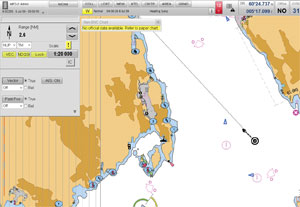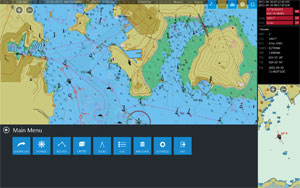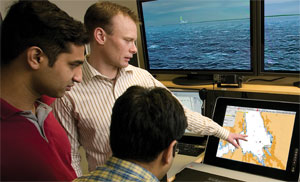The industry is bracing for updated standards for electronic chart display and information systems (ECDIS) that go into effect in August 2016, as deck officers face a training certification deadline by the end of the year.
The revisions to the International Convention on Standards of Training, Certification and Watchkeeping for Seafarers (STCW) that mandated ECDIS Jan. 1, 2012, gave mariners until Dec. 31, 2016, to comply with training on the computerized chart systems that are replacing paper charts on many bridges around the world. Current credentials and endorsements should continue to be honored by port state inspectors in the U.S. and around the world until January 2017. In the meantime, ECDIS manufacturers and shipowners are upgrading existing systems to meet the latest revised standards.
“I think the industry is more or less ready,” said Hans Ottosen, chief executive of ECDIS maker Danelec Marine. “We have had the first wave of implementation on passenger vessels and tankers, and we’re going into the second, larger wave on cargo ships.”
ECDIS, a computer-based navigation system that uses electronic charts, was first certified by the International Maritime Organization (IMO) in 1995. In 2008, IMO accepted recommendations to make ECDIS compulsory on all newbuild vessels with keels laid either on or after July 1, 2012. Existing vessels will be required to retrofit the system at the first survey after certain dates in the regulations depending on the vessel type and size. Ships may be exempt from the requirements if they will be taken permanently out of service within two years after the implementation date specified. ECDIS requirements were phased in starting in July 2012 with large newbuild passenger ships and tankers, and will finish in July 2018 with cargo ships of between 10,000 and 20,000 gross tons that were constructed prior to July 1, 2013.
Vessels must have both a primary ECDIS and a backup arrangement that can duplicate the additional functions, which can be a second ECDIS or paper nautical charts.
For U.S.-flag vessels, ECDIS is not yet mandatory but an approved ECDIS meets the requirements for nautical charts and backups to relieve the owner and operator of the need to unnecessarily pay for both ECDIS and paper charts. Currently paper charts remain an allowed backup option.
This affects U.S.-flag ships of 150 or more gross tons that engage in international voyages; those certificated solely for service on the Great Lakes and the St. Lawrence River; and foreign-flag ships to which SOLAS Chapter V applies that are operating on the navigable waters of the U.S. The policy does not apply to U.S.-flag ships engaged only on domestic voyages.
Ships already equipped with ECDIS, newbuilds and vessels of the type that will require ECDIS in the future will have to comply with the latest ECDIS standards from the International Electrotechnical Commission (IEC) and the International Hydrographic Organization (IHO). ECDIS users have until Aug. 31, 2016, to implement the new standards, the end of a yearlong transition period.
 |
|
A screenshot of a display when no electronic chart is available. |
|
Courtesy Kongsberg Maritime |
ECDIS is one of the few shipboard devices for which older versions are not grandfathered in. Instead, to satisfy the SOLAS Chart Carriage Requirements using ECDIS and electronic navigational charts, the installed system must comply with the latest IHO standards.
Not all systems are upgradeable, so a vessel owner may have to purchase a newer system to meet the requirements.
“We know in a number of cases an ECDIS that’s more than a few years old may not be upgraded, and some shipowners are not happy about it but that’s the situation,” Ottosen said.
The new standards will reduce the number of audible alarms triggered by ECDIS, helping ease the issue of alarm fatigue on the bridge, while still maintaining safety at sea, according to Thomas Mellor, chairman of the IHO ENC Standard Maintenance Working Group.
Also, the new standards address security issues and standardization for displays, vocabulary and operation, making it easier for bridge officers to transition to different ships.
However, installing a new EDCIS or upgrading an existing unit will not require new training if the crew is already certified, according to Anders Rydlinger, navigation product director for Transas, an ECDIS manufacturer and trainer.
Any master, chief mate or deck officer who will serve as an officer in charge of a navigational watch (OICNW) must be trained to use ECDIS. Industry experts estimate that about 250,000 mariners worldwide will receive ECDIS training.
Under the STCW amendments, ECDIS is treated as a negative endorsement, which means it’s only mentioned on a mariner’s certification if he or she has not qualified. Certification is not required for those who serve exclusively on ships not fitted with ECDIS.
ECDIS users must complete two stages of training. The first is a 40-hour generic training on ECDIS concepts, and the second is a two-day familiarization with the specific type of ECDIS that the mariner will use on the vessel. The familiarization training can be done at a manufacturer’s training center, via computer-based training, or on a vessel by a trainer that has completed a train-the-trainer course.
ECDIS manufacturers including Danelec Marine and Transas have established training centers for their units. Transas has formed the Global ECDIS Training Network to provide the shipping industry with high-quality standardized and certified ECDIS training through a network of manufacturer-approved training providers. The network operates in 20 countries.
 |
|
A screenshot of an electronic chart on a Danelec ECDIS system. This year, new ECDIS carriage, standardization and training rules are going into effect internationally. |
|
Courtesy Danelec Marine |
Kongsberg Maritime offers instructor training, which ultimately prepares captains to train their own crews, with an online testing component for verification.
Training is considered vital to avoid “ECDIS-assisted groundings” similar to a rash of radar-assisted collision incidents that occurred in the transition to ARPA.
One fear is that bridge personnel will become over-reliant on the technology and not apply seamanship skills. Capt. Jorge Viso, a pilot in Tampa Bay and vice president of the South Atlantic region of the American Pilots’ Association, has seen this problem firsthand on vessels already equipped with ECDIS.
“I’ve been on foreign-flag tankers and newbuilds. You look around and realize there are no paper charts. They’ve fully made the transition,” Viso said. “But on some vessels they’re so wrapped up with the ECDIS they’re not looking out the window.”
In some port states there is no requirement to actually use ECDIS as the primary means of navigation, and some shipowners are using this loophole to use both systems in parallel to ensure their crews are competent in using ECDIS. Requirements vary by port state control schemes, some of which require that if the ECDIS is listed in the safety equipment certificate, it must be the primary means of navigation.
“Some vessel owners are worried about the quality of training being received and don’t want to commit fully to ECDIS unless they know their officers are competent in using it,” said Capt. Harry Gale, technical manager for the London-based Nautical Institute. “It’s the same as anything else. You don’t give someone a mate’s job unless you know they are competent.”

